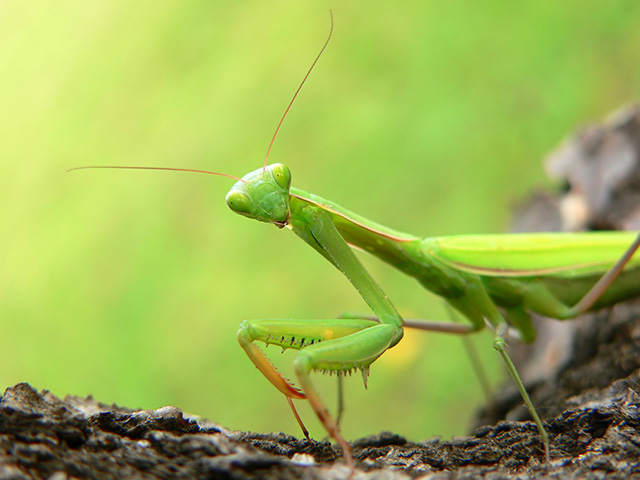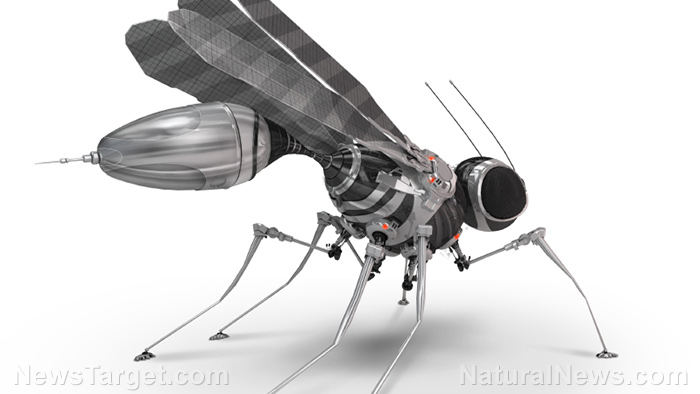As advanced as robots have become, they’re still incapable of performing certain tasks. One of these is the ability to judge distance accurately. However, a team of scientists from Newcastle University may have found a solution to this problem, and they uncovered it by giving praying mantises tiny 3D glasses.
Praying mantises are unique from other insects in that they possess massive, forward-facing eyes, much like humans and other primates do. Having this sort of vision set up allows us to use both of our eyes to assess depth by way of contrasting two different views. This is known as stereoscopic vision. Praying mantises have their own form of stereoscopic vision that, remarkably, help them see the world in an extraordinary way.
That’s a discovery the team found out when they affixed bespoke 3D glasses onto ten adult praying mantises with beeswax. Unlike humans, praying mantises are unable to see red very well, so the researchers used blue and green lenses instead. The insects were then suspended in front of a computer screen and shown a series of images that ranged from moving dots to ornate dot patterns. The team also intermittently changed the background pattern between images.
The praying mantises attacked the moving dot, showing that they could identify the depth of mobile objects. When the dot was made to move in two different directions, the praying mantises still attacked it. Even when the backgrounds changed, the insects were still able to judge the distance to the dot and attack.
“Mantises only attack moving prey, so their 3-D doesn’t need to work in still images. We found mantises don’t bother about the details of the picture, but just look for places where the picture is changing,” explained study author Dr. Vivek Nityananda. He added that it made sense given these animals have less than a million neurons. It would be more efficient for their brains to focus on what’s important (in their case, prey) and ignore all other background information.
Despite their limited processing power, they were still able to see in three dimensions. The researchers noted that this simplistic type of vision could be applied to robots. “Current machine stereo algorithms require a lot of computing power,” said Nityananda. “Reducing the amount of computer power necessary means smaller, lightweight robots could use mantis stereo algorithms to detect depth.” (Related: Air drop delivery: Drones are being used in Rwanda to deliver blood and medicine to remote hospitals.)
Nityananda’s fellow researcher, Dr. Ghaith Tarawneh, echoed his statement in a separate remark to DigitalTrends.com: “So far we’ve been designing these systems to see and react to the world in the same way we do, but our brains are immensely complex and power hungry machines that may not be the ideal biological model to inspire efficient design.
“Mantis 3-D vision uses the exact sort of computational trickery that challenges our way of seeing things: A view of the world radically different from ours, but evidently more fit for purpose. Adapting autonomous cars and drones after insect vision can give them the same capabilities: A superior ability to see the details that matter with shorter reaction times and longer battery life.”
Fast facts about praying mantises
- Of the 2,400 different species of mantises, the vast majority live in tropical and temperate climates. Only 18 species are known to be native to North America.
- Thanks to a flexible joint between their head and prothorax, mantises can rotate their heads a full 180 degrees.
- Mantises are related to termites and cockroaches. Entomologists believe that these three seemingly different insect species come from one common ancestor.
- Despite their reputation for consuming the males, female mantises typically don’t engage in cannibalism during consummation. This usually occurs in a laboratory setting. Outside and in the wild, this is thought to happen no more than 30 percent of the time.
Visit Robotics.news to read up on more news about technological advancements.
Sources include:
DailyMail.co.uk
DigitalTrends.com
ThoughtCo.com



















